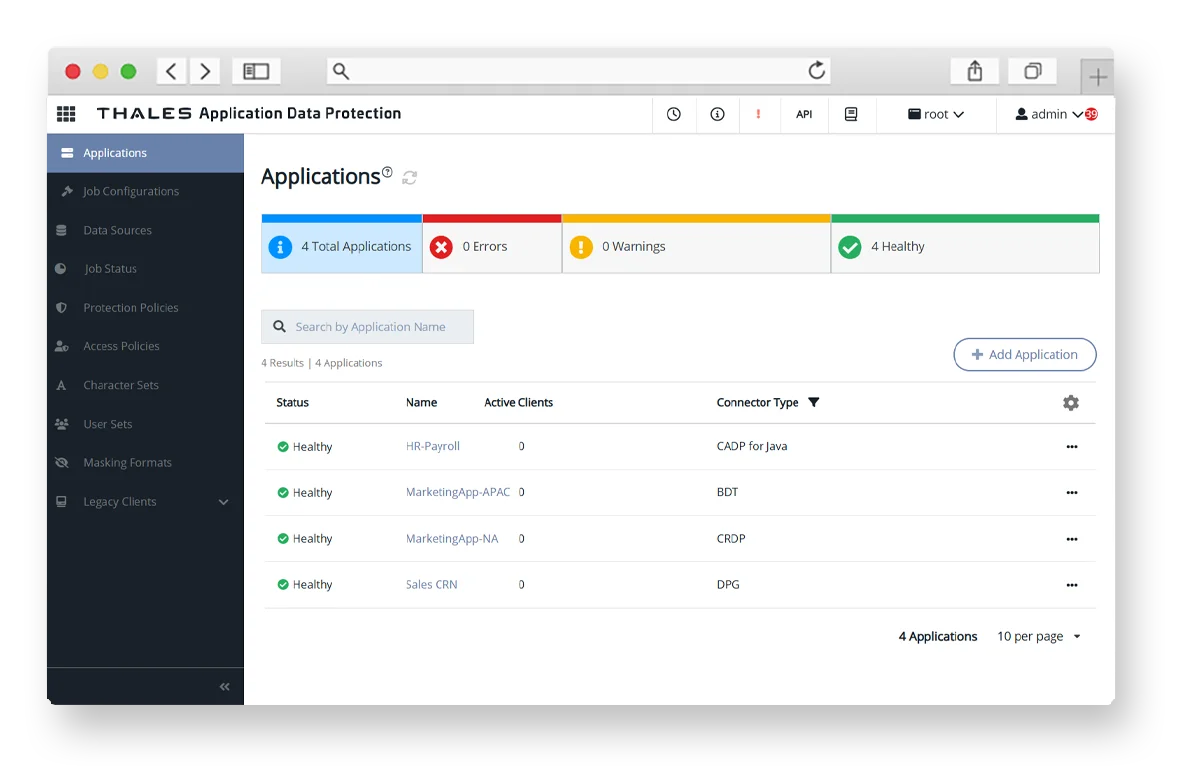Data Protection Gateway (DPG) protects RESTful web services and microservices with no change to code, ever.
Updates are no longer made in code
No Dev Involvement
- Transparent data protection for JSON payloads
- < 1 minute to close vulnerability gaps for sensitive data
- Keep on top of the latest data security without creating major projects
Increase Dev Capacity
- Reduce the drag on the Dev team
- Pass responsibility for data protection to the data security team via simplified APIs
Separation of Duties
- Data Security Admins control the what, the how, and the who via centrally managed policies
- Crypto agility enables Data Security Admins to change ciphers, parameters and keys in real time
Just as you use different keys for different columns in your database, you use different ciphers for different types of data. Learning and applying the rules of cryptography is time-consuming and you have more exciting projects to work on.”
Apply any type of data protection from a single interface
DPG supports tokenization, encryption and data generalization so that organizations can optimize data protection for each piece of data to decrease the risk of sensitive data being leaked. DPG supports format preservation to fit each organization’s current schema so that organizations don’t have to make changes in their environment.
DPG supports Data Masking and Redaction to reveal sensitive data on a need-to-know basis.
- Static Data Masking masks the data that doesn’t need to be accessed, revealing only the data relevant to the group – this is especially valuable for data analysts (pseudonymization) and increased performance for customer service (data is already masked when it arrives).
- Dynamic Data Masking is preferred when users with different access levels will be accessing the data and have rights to access different parts of the data.
- Redaction provides an absolute mask that shows a field with redacted data or hides the field.
Centralized management
Audits become accurate, significantly faster and complete due to visibility of all policies on a single pane of glass showing where Connectors are deployed and the corresponding version numbers.
CipherTrust Manager provides a centralized view of every crypto agile Connector’s status—whether operational, offline, or requiring attention, alongside metrics such as health and last check-in time. Data Security Administrators can instantly drill down into individual Connectors for detailed information, configuration adjustments or automated remediation.

We have Tokenization and Encryption solutions to meet your security and infrastructure requirements.
Benefits for each role
With DPG, you can have GOOD + FAST + CHEAP, right now.
- More revenue, due to increased Dev capacity
- More security, due to < 1 minute to close vulnerability gaps
- More innovation, due to not increasing the backlog
Close vulnerability gaps in < minute, Roadmap is respected (because there are no data protection fire drills taking Devs off revenue-generating projects).
Devs can remain focused on revenue-generating projects because they are not involved in updating data protection.
No downtime or fire drills required to update data protection.
Ultra secure (staying on top of your security posture by closing vulnerability gaps in < minute), Roadmap is respected (because there are no data protection fire drills taking Devs off revenue-generating projects).
Visibility into current security posture (single pane of glass, centralized-management, policy-based), No code change to make updates (removes dependency on DevOps for updates).
Reputation is protected, audits are passed, in compliance, does not add to technical debt.
Audits are passed, in compliance, empowered to update data protection whenever needed.
No need to learn crypto or do the data protection updates, does not add to technical debt.

CipherTrust Data Protection Gateway
Operating transparently to all entities on the network, DPG interprets RESTful data and performs protection operations based on profiles defined centrally in CipherTrust Manager. DPG is deployed as a container and is fully compatible with Kubernetes orchestration systems. DPG can also be deployed as a standalone container for development and testing use cases as well as legacy production deployments.